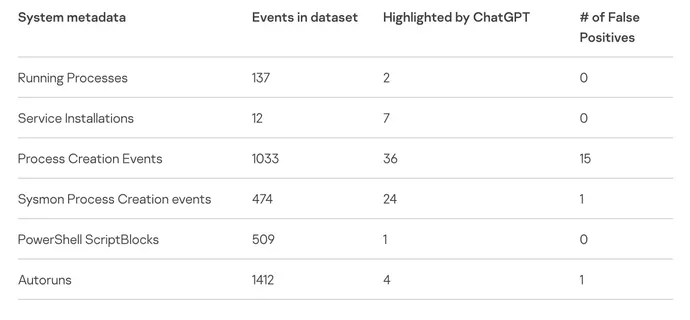A number of experiments suggest that ChatGPT, the popular large language model (LLM), could be useful to help defenders triage potential security incidents and find security vulnerabilities in code, even though the artificial intelligence (AI) model was not specifically trained for such activities, according to results released this week.
In a Feb. 15 analysis of ChatGPT’s utility as an incident response tool, Victor Sergeev, incident response team lead at Kaspersky, found that ChatGPT could identify malicious processes running on compromised systems. Sergeev infected a system with the Meterpreter and PowerShell Empire agents, took common steps in the role of an adversary, and then ran a ChatGPT-powered scanner against the system.
The LLM identified two malicious processes running on the system, and correctly ignored 137 benign processes, potentially reducing overhead to a significant degree, he wrote in a blog post describing the experiment.
“ChatGPT successfully identified suspicious service installations, without false positives,” Sergeev wrote. “For the second service, it provided a conclusion about why the service should be classified as an indicator of compromise.”
Security researchers and AI hackers have all taken an interest in ChatGPT, probing the LLM for weaknesses, while other researchers, as well as cybercriminals, have attempted to lure the LLM to the dark side, setting it to produce better phishing emails messages or generate malware.

Yet security researchers are also looking at how the generalized language model performs on specific defense-related tasks. In December, digital forensics firm Cado Security used ChatGPT to create a timeline of a compromise using JSON data from an incident, which produced a good — but not totally accurate — report. Security consultancy NCC Group experimented with ChatGPT as a way to find vulnerabilities in code, which it did, but not always accurately.
The conclusion is that security analysts, developers, and reverse engineers need to take care whenever using LLMs, especially for tasks outside the scope of their capabilities, says Chris Anley, chief scientist at security consultancy NCC Group.
“I definitely think that professional developers, and other folks who work with code should explore ChatGPT and similar models, but more for inspiration than for absolutely correct, factual results,” he says, adding that “security code review isn’t something we should be using ChatGPT for, so it’s kind of unfair to expect it to be perfect first time out.”
Analyzing IoCs With AI
The Kaspersky experiment started with asking ChatGPT about several hackers’ tools, such as Mimikatz and Fast Reverse Proxy. The AI model successfully described those tools, but when requested to identify well-known hashes and domains, it failed. The LLM could not identify a well-known hash of the WannaCry malware, for example.
The relative success of identifying malicious code on the host, however, led Kasperky’s Sergeev to ask ChatGPT to create a PowerShell script to collect metadata and indicators of compromise from a system and submit them to the LLM. After improving the code manually, Sergeev used the script on the infected test system.
Overall, the Kaspersky analyst used ChatGPT to analyze the metadata for more than 3,500 events on the test system, finding 74 potential indicators of compromise, 17 of which were false positives. The experiment suggests that ChatGPT could be useful for collecting forensics information for companies that are not running an endpoint detection and response (EDR) system, detecting code obfuscation, or reverse engineering code binaries.
Sergeev also warned that inaccuracies are a very real problem. “Beware of false positives and false negatives that this can produce,” he wrote. “At the end of the day, this is just another statistical neural network prone to producing unexpected results.”
In its analysis, Cado Security warned that ChatGPT typically does not qualify the confidence of its results. “This is a common concern with ChatGPT that OpenAI [has] raised themselves — it can hallucinate, and when it does hallucinate, it does so with confidence,” Cado’s analysis stated.
Fair Use and Privacy Rules Need Clarifying
The experiments also raise some critical issues regarding the data submitted to OpenAI’s ChatGPT system. Already, companies have started taking exception to the creation of datasets using information on the Internet, with companies such as Clearview AI and Stability AI facing lawsuits seeking to curtail their use of their machine learning models.
Privacy is another issue. Security professionals have to determine whether submitted indicators of compromise expose sensitive data, or if submitting software code for analysis violates a company’s intellectual property, says NCC Group’s Anley.
“Whether it’s a good idea to submit code to ChatGPT depends a lot on the circumstances,” he says. “A lot of code is proprietary and is under various legal protections, so I wouldn’t recommend that people submit code to third parties unless they have permission to do so.”
Sergeev issued a similar warning: Using ChatGPT to detect compromise sends sensitive data to the system by necessity, which could be a violation of company policy and may present a business risk.
“By using these scripts, you send data, including sensitive data, to OpenAI,” he stated, “so be careful and consult the system owner beforehand.”


